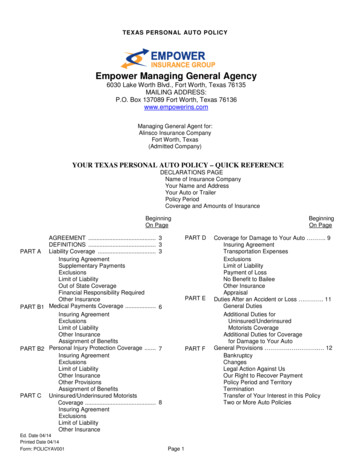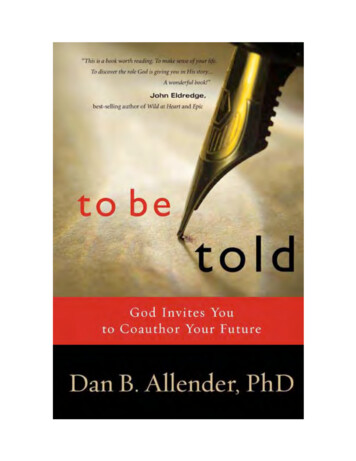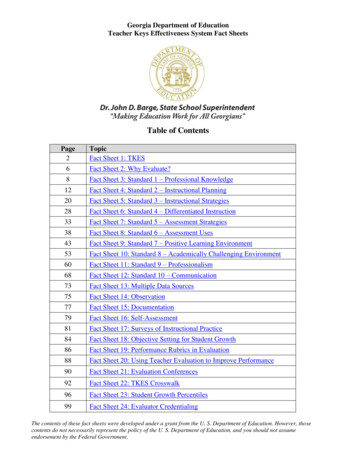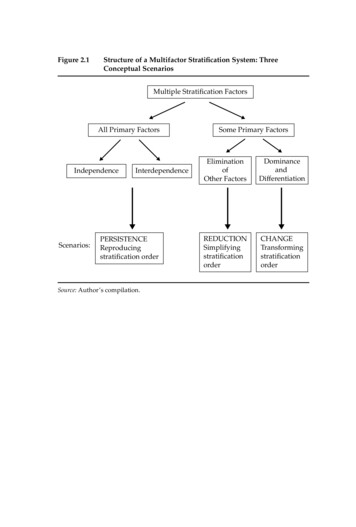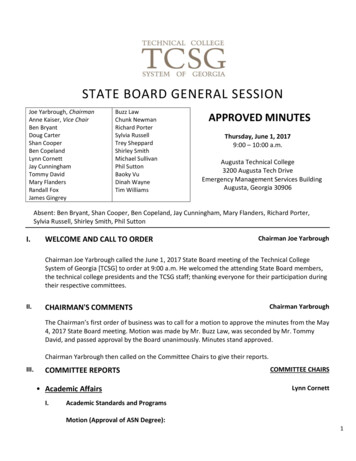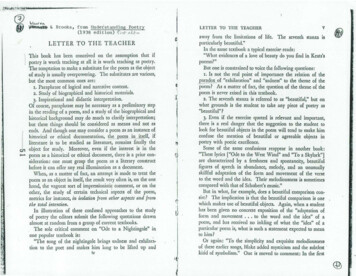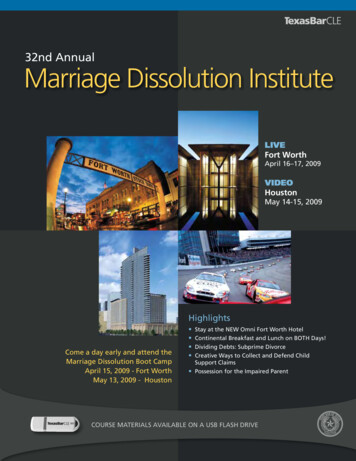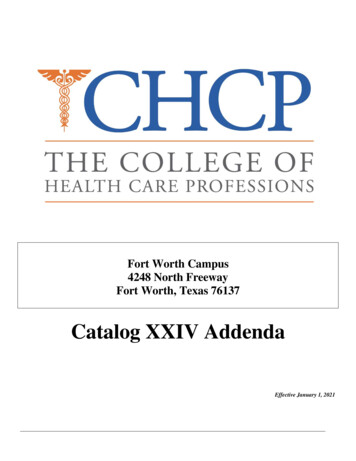
Transcription
THEA Year’s Worth of Devotionsfor the Whole FamilyMake regular devotions part of your family life with this easy-touse resource aimed at helping children understand the big pictureof the Bible.Designed as a complementary resource to the best-selling The BigPicture Story Bible, this family devotional offers parents a year’sworth of material for teaching children ages 6–10 about God’s planof salvation for the world through Christ.F A M I LY D E V O T I O N A LIntended for families to use three times per week,each 5- to 10-minute lesson includes: a basic Bible question with an accompanyinganswer in the form of a memory verse a carefully chosen Scripture passage to read aloud a short devotion designed to help kidsconnect the Scripture passage to the Bible’soverarching message reflection questions for the whole family to discuss togetherF A M I LYDEVOTIONALDAVID R. HELM serves as a lead pastor at Holy Trinity ChurchHELMin Chicago. He is also chairman of the Charles Simeon Trust, whichpromotes practical instruction in preaching. He is the author of anumber of books, including The Big Picture Story Bible and The BigPicture Bible Verses.Tracing the Storyline of the Bible9 781433 54225151299U.S. 12.99CHILDREN AGES 6–10ISBN-13: 978-1-4335-4225-1ISBN-10: 1-4335-4225-0EDITED BYDAVID R. HELM
The Big Picture Family Devotional
The Big PictureFA M I LY D E VO T I O N A Ledited by David R. HelmW H E AT O N , I L L I N O I S
The Big Picture Family DevotionalCopyright 2014 by Holy Trinity ChurchPublished by Crossway1300 Crescent StreetWheaton, Illinois 60187All rights reserved. No part of this publication may be reproduced, stored in a retrievalsystem, or transmitted in any form by any means, electronic, mechanical, photocopy,recording, or otherwise, without the prior permission of the publisher, except as providedfor by USA copyright law.Cover Illustration: Gail SchoonmakerFirst printing 2014Printed in the United States of AmericaScripture quotations are from the ESV Bible (The Holy Bible, English Standard Version ),copyright 2001 by Crossway. 2011 Text Edition. Used by permission. All rights reserved.All emphases in Scripture quotations have been added by the author.Trade paperback ISBN: 978-1-4335-4225-1ePub ISBN: 978-1-4335-4228-2PDF ISBN: 978-1-4335-4226-8Mobipocket ISBN: 978-1-4335-4227-5Library of Congress Cataloging-in-Publication DataThe big picture family devotional / David R. Helm.pages cmISBN 978-1-4335-4225-1 (tp)1. Families—Religious life. 2. Christian education of children.3. Christian education—Home training. 4. Families—Prayersand devotions. I. Helm, David R., 1961– editor.BV4526.3.B54 2014242'.2—dc23 2014005724Crossway is a publishing ministry of Good News Publishers.VP1514241323122211211020 19 189 8 7 617516 15 144 3 2 1
ContentsAcknowledgments 9How to Use This Devotional 11Part 1God Creates His KingdomQuestions 1–91 God Creates a Place 152 God Creates a People 183 God Is Pleased with His Place and His People 214 God Is King over His Place and His People 245 God’s People Reject God as King 276 God’s Place Is Forever Changed 307 God’s People Are Forced Out 338 Everyone Now Rejects God as King 369 God Judges Everyone Who Rejects Him as King 39Review of Questions 1–9: God Creates His Kingdom 42Part 2God Begins His PromiseQuestions 10–1810 God Promises a New Place to a New People, Who Will Bless All People4711 Abraham Believes God’s Promise 5012 God’s Promises Extend from Abraham to Isaac and Jacob 5313 Israel Enters Egypt 5614 God Rescues Israel from Egypt 59
15 God Tells Israel How to Live as His People 6216 God Sets Israel Apart to Be His People 6517 Israel Promises to Live as God’s People 6818 God Keeps All His Promises to Israel 71Review of Questions 10–18: God Begins His Promise 74Part 3God Continues His PromiseQuestions 19–2719 Israel Rejects God as King 7920 God Is Not Surprised 8221 God Promises a New King 8522 God Promises a New Place 8823 The Kings of the Earth Reject God’s Promises 9124 The Kings of Israel Reject God’s Promises 9425 Israel Enters Exile 9726 The Ragged Return of Israel from Exile 10027 God Promises a New People 103Review of Questions 19–27: God Continues His Promise 106Part 4Jesus Fulfills God’s PromiseQuestions 28–3628 Jesus Is Born 11129 Why Jesus Came 11430 How Jesus Saves 11731 You Must Be Born Again 12032 Jesus Is the Resurrection 12333 Jesus Is the Only Way 12634 Jesus Is Crucified 12935 Jesus Died for Our Sins 132
36 Jesus Rose from the Dead 135Review of Questions 28–36: Jesus Fulfills God’s Promise 138Part 5God Completes His PromiseQuestions 37–4537 Spreading the Gospel of Jesus 14338 Peter Defines the Gospel 14639 Paul Defines the Gospel 14940 Believing the Gospel 15241 Living as People Set Apart 15542 Living as God’s New Creation 15843 Living as People with Hope 16144 All to the Glory of God 16445 Comfort from the King 167Review of Questions 37–45: God Completes His Promise 170Big Picture Songs 173
AcknowledgmentsOne of the immense privileges of pastoring a church plant is the opportunityto colabor in the gospel with eager and energetic Christians—people whoput their desire to make an impact for Christ to work by experimenting withnew ideas to strengthen the church. In that context, The Big Picture FamilyDevotional was born.In the fall of 1996, in the very early days of our church plant in Chicago, acommitment arose to provide fresh gospel resources for the many young families who were instructing their children in the faith. Because we believe thehome is the central place for Christian education, the idea of writing a familydevotional made sense. Soon afterward, the church was buzzing with excitement as members began writing devotional material that attempted to tracethe storyline of the Bible. We even found ourselves writing Sunday schoolcurriculum and adult small group study guides to supplement what was taking place around our dinner tables. Kids and adults alike began memorizingforty-five big picture verses that function as windows through which we gazeat God’s unfolding promise. It was during these years that God also allowedme the privilege of writing The Big Picture Story Bible, beautifully illustratedby Gail Schoonmaker.I would like to express my deep appreciation to Graeme Goldsworthy,whose ideas on biblical theology provided a springboard for us, as well as myadmiration for the many members of Holy Trinity Church, Chicago, who joyfully labored in writing bits and pieces of what you now hold in your hands.The Big Picture Family Devotional is not the work of one person, but many—toomany to mention them all by name! Special thanks go to Helen-Joy Lynerdfor helping me prepare this book for publication. Also, I am indebited to TaraDavis of Crossway for her careful editing of the manuscript.Finally, I want to acknowledge the children of Holy Trinity Church,Chicago—for you we gladly labor, counting it sweet joy.9
How to Use This DevotionalThe difficulty of devotions. Most people find doing family devotions difficult.For starters, many of us never had devotions modeled at home. Even if we werefortunate enough to grow up in a home with parents who tried to teach us thebasics of religious belief, we must admit that today is a different world—onethat presents us with practical challenges most of our parents never faced.Let’s face it: today a family often eats meals at different times. Getting everyone together in the same place at the same time is nearly impossible.How to use this devotional. Take heart! We live in the same world you do,and have written The Big Picture Family Devotional especially for today’s family. Getting through this devotional in one year requires only three times aweek when your family is in the same place at the same time. We even limitedthe material to fifty rather than fifty-two weeks so you can put this down anddo something else for devotions during the weeks of Christmas and Easter.The devotional contains forty-five weeks of content and five weeks of reviewspread throughout the year. Everything is already prepared for you, savingyou the time of trying to figure out something productive to share with yourkids. Just open up the book and read the short Bible selection for the day andthe brief devotional paragraph that unfolds the message of the Bible. Followthat up with the reflection and interaction prompts that are meant to spurfamily discussion. The entire process can take as little as five to ten minutes—or longer, at those unexpected but enjoyable leisurely times when your kidsare particularly interested.The devotional is geared for children ages six to ten, with the intentionthat it will be read through over several years so that the concepts are reinforced and children grow into an understanding of the more advanced ideas.For those who want more. For families who like to sing, we have includedsongs that reinforce what you are learning together. For the highly motivated,we encourage you to make use of the forty-five memory verses that trace thebig picture of the Bible. We call them the big picture verses, and a little booklet11
How to Use This Devotionalcontaining just the verses is available (titled The Big Picture Verses: Tracing theStoryline of the Bible). The verses can easily work as a catechism that takes youfrom Genesis to Revelation.The word catechism comes from the Greek katēchein, which means “toteach.” The Big Picure Bible Verses is a tool that will help parents teach theirchildren the storyline of the Bible through questions and answers.We hope The Big Picture Devotional will help clarify the main message ofthe Bible and instill in your family a growing confidence that the words of theBible are the very words of God!12
PA RT 1God Creates His KingdomQuestions 1–9
Question 1God Creates a PlaceQ. Who created the heavens and the earth?A. In the beginning, God created the heavens and the earth.(Genesis 1:1)Bible Reading: Genesis 1:1Devotional Reading: The Bible Assumes God’s ExistenceThe Bible opens with these amazing words: “In the beginning, God.” Haveyou ever stood outside at night and looked up into the stars and wondered,“How did all this get here? How did I get here?” In its very first verse, the Biblereveals the answer to those questions. The Bible says that God exists and thathe created the heavens and the earth! Many people question whether Godexists. Some are certain there is a God, others are unsure, while still othersthink that God is only an idea in your mind and not real after all. But guesswhat? The Bible doesn’t waste any time arguing about the existence of God.It simply begins by saying, “In the beginning, God.” How refreshing! The firstwords of the Bible are already hinting at its big picture—the unfolding activityof God in history.R E F L E C T I O N A N D I N T E R AC T I O NMemorize the question and answer of our first big picture verse: Genesis 1:1.What does today’s Bible reading teach you about God?15
Question 1Q. Who created the heavens and the earth?A. In the beginning, God created the heavens and the earth.(Genesis 1:1)Bible Reading: Genesis 1:1–2Devotional Reading: The Bible Begins with GodCreating the Heavens and the EarthHave you ever wanted to create something? Perhaps you had an idea in yourhead and you wondered if you could make it. Let’s suppose you were goingto try. What is one of the first things you would need to do before starting?You would have to gather all the materials your idea needed. Did you knowthat God did something like that when he created the world? When God setout to create the heavens and the earth he first had to create the materialsthemselves! The Bible tells us that when God first made the earth, it was onlya dark and watery mass. The basic materials were all there, but it didn’t lookthe way it does now. It looked strange. Nothing could live on it—certainly notpeople like you and me! How amazing it would have been to see God creatingand assembling all the materials he needed to make his wonderful creation.R E F L E C T I O N A N D I N T E R AC T I O NWould you say the Bible reading today is more concerned to teach you aboutthe heavens or the earth?What does the Bible’s concern with the earth here tell you about the focus ofGenesis 1?16
Question 1Q. Who created the heavens and the earth?A. In the beginning, God created the heavens and the earth.(Genesis 1:1)Bible Reading: Genesis 1:3–25Devotional Reading: God Formed Places and Then Filled ThemOften when you want to color a picture of something, you first draw, or form,the outline of the object or person to be colored and then fill in the color. Well,something like that is going on in Genesis 1. It’s as if the writer gives us anoutline of what happened in the first few verses and then fills in the detailslater in the chapter. The creation outline of day 1 gets filled in on day 4. Onday 1 we learn about light and darkness, day and night. Then on day 4, we areintroduced to the sun and the moon and the stars, which fill up the sky. Isn’tthat amazing! The outline of day 2 (the heavens and the seas) is filled in on day5 (the birds and sea creatures). And day 3 (the earth and plants) correspondsto day 6 (the land animals). The writer wants you to see the overall picture ofGod’s creative activity. He wants you to know that God formed all the placesin the universe (days 1, 2, and 3), and then filled those places with creations torule over them (days 4, 5, and 6). Finally, notice that the writer says God didall this simply by speaking words (see vv. 3, 6, 9, 11, 14–15, 20, and 24)! Imaginecreating something that was an idea in your head by talking it into existence!R E F L E C T I O N A N D I N T E R AC T I O NCan you create things simply by speaking words? What does God’s ability todo so teach you about God?Learn “The Creation Song” found on pages 174–75.17
Question 2God Creates a PeopleQ. Who created people?A. God created man in his own image, in the image ofGod he created him; male and female he created them.(Genesis 1:27)Bible Reading: Genesis 1:26–31Devotional Reading: People Are Created in God’s ImageThe Bible makes it clear that people are very special to God. In fact, we arethe crowning jewel of God’s creation. God did not make people to be like therest of creation, “God created man in His own image, in the image of God hecreated him; male and female he created them.” An image is a reflection ofsomeone or something. When you look in the mirror, you see your own reflection, or image. God made us to reflect his image. That doesn’t mean we looklike God. Instead, it means that we are like him; we rule over things, just asGod does. In ancient times, kings used to set up monuments in faraway partsof their empire to show that they ruled there (often these monuments werestatues made to look just like them). In a similar way, God has set us up to ruleover his creation. As his image-bearers, we act as his representatives in theworld. Later on in the Bible story, the psalmist will pick up on this same idea(Psalm 8), and then, the writer of the book of Hebrews will show us that Jesusis God’s supreme image-bearer (Heb. 2:5–8). This is important for us becauseit teaches us how we extend God’s rule today—namely, by living under therule of Christ.R E F L E C T I O N A N D I N T E R AC T I O NWhat does being made in the image of God teach you about God’s plans foryou?Memorize the big picture verse for this week: Genesis 1:27. If you memorizeone each week, you will learn all forty-five verses that trace the storyline ofthe Bible!18
Question 2Q. Who created people?A. God created man in his own image, in the image ofGod he created him; male and female he created them.(Genesis 1:27)Bible Reading: Genesis 2:18–25Devotional Reading: People Are the Pinnacle of God’s CreationHave you ever seen a road map? It’s helpful because it shows you many roads.Some maps even come with an inset map. This highlights in greater detailone part of the road map. Genesis 1 and 2 function much like a road map.After giving us the large map of creation in chapter 1, God highlights the mostimportant part of creation in chapter 2—people! He wants you to see the creation of people in greater detail. The point is clear: God created this place forpeople. We learn that Adam loved everything about his life in the garden, except for one thing: he was alone. The animals all had partners, but not Adam.In fact, one of the reasons God had Adam name the animals was to preparehim for Eve. God said, “It is not good that man should be alone; I will makehim a helper.” So God had Adam fall into a deep sleep. While Adam was sleeping, God took one of Adam’s ribs, and from this rib he “built” a woman. Asonly God could do, he created the perfect companion for Adam. This teachesus another thing about being made in God’s image. We are meant for relationship. Not only does man have a special relationship with woman, but bothmen and women have a unique relationship with God.R E F L E C T I O N A N D I N T E R AC T I O NWhy did God ask Adam to name all the animals?What was special about Adam’s relationship with Eve that was different fromhis relationship with God’s other creatures?19
Question 2Q. Who created people?A. God created man in his own image, in the image ofGod he created him; male and female he created them.(Genesis 1:27)Bible Reading: Genesis 1:26–31Devotional Reading: People Are to Ruleover the Rest of God’s CreationWhen children are born, who is responsible for them? Parents are. Parentsprepare meals, teach their children to get dressed, and help them learn whatis right from wrong. Parents are responsible for their children. Do you knowwho is responsible for caring for God’s creation? All of us are. When God created the world and everything in it, he made us responsible for his creation.God gave us the wonderful responsibility of ruling over and caring for all thathe created. That means the entire earth and everything in it. It is God’s world,but he appointed us to rule it for him.R E F L E C T I O N A N D I N T E R AC T I O NDiscuss some ways that we care for God’s world.Can you think of some ways that we rule God’s world?20
Question 35Jesus Died for Our SinsQ. Did Jesus say God’s promise was fulfilled when he wascrucified?A. [Jesus] said, “It is finished.” (John 19:30)Bible Reading: John 19:16–18, 28–30Devotional Reading: Jesus Was Victorious on the CrossDo you know what a mystery is? A mystery is something that can’t be under stood, unless someone explains it to you. Remember when we wonderedhow God could allow Jesus to die on the cross if he had never committed anysins? This week we will unravel that mystery. Jesus wasn’t dying for sins thathe had committed; rather, he was dying for our sins. His death was fulfillingGod’s rescue plan. And so, when Jesus had done everything God had askedhim to do on the earth, he called out in a loud voice, “It is finished!” Jesussaid these words like someone who just finished doing something great. Heaccomplished his goal. He finished his task. He was the perfect sacrifice forsins. If you want to know if your sins are forgiven, look back to the death ofJesus. He is the only perfect sacrifice for our sin. And his death is the answerto the mystery of how God would rescue us from sin. God sent his only Son topay the penalty for our disobedience.R E F L E C T I O N A N D I N T E R AC T I O NHow do you think Jesus felt about finishing the work of paying for our sin?What does Jesus’s death on the cross teach you about God’s love for you?Memorize this week’s big picture verse: John 19:30.132
Question 35Q. Did Jesus say God’s promise was fulfilled when he wascrucified?A. [Jesus] said, “It is finished.” (John 19:30)Bible Reading: Genesis 3:23; 6:17; Exodus 12:21;Isaiah 5:13; John 2:19Devotional Reading: God Banished Jesus from His Presence for UsWe read five different verses from the Bible today—and they were all memoryverses from earlier times in our devotional. Each one points us to being ableto understand what was happening when Jesus died on the cross. Jesus wasbanished for our sins. Jesus perished. Jesus was the sacrificial Lamb. Jesusrepresents God’s people who go into exile. Jesus’s death is the destructionof the Temple. The Bible has been showing us all along the penalty for sin. Itrequires separation from God. He banished Adam and Eve from the garden;he caused everything to perish in the flood; he killed all the firstborn Egyptians at the time of the Exodus; he sent Israel into exile; and he had Solomon’stemple destroyed to show that he was separated from his people because oftheir sin. Now, Jesus’s death shows us what all those events meant. Jesus takeson the punishment for the sin of his people. He was abandoned by God whenhe died on the cross (Mark 15:33–34). In his death you see the extent of God’slove for you!R E F L E C T I O N A N D I N T E R AC T I O NDo you see how the New Testament helps us understand the Old Testament?Thank God for giving us all the clues we need to understand the mystery ofhis great love.133
Question 35Q. Did Jesus say God’s promise was fulfilled when he wascrucified?A. [Jesus] said, “It is finished.” (John 19:30)Bible Reading: John 19:30Devotional Reading: Jesus’s Death Is theGood News of God’s RescueLet’s do a quick review of the Gospel of John. First, we heard things said aboutJesus. Do you remember the words of the angels and John the Baptist? Thenwe listened to the many things Jesus said and did. Remember his words aboutthe temple, the kingdom, the resurrection, and the Way? We even learnedthat Jesus raised someone from the dead. Next we saw what others did to Jesus.They crucified him on the cross. And this week we are learning about whatJesus said about what they did: “It is finished!” The Gospel of John gives us thewords and actions of others and the words and actions of Jesus to help us seethat Jesus’s death is God’s plan to rescue us from sin.R E F L E C T I O N A N D I N T E R AC T I O NDo you believe that Jesus died on the cross to rescue you from your sin?If actions speak louder than words, what does Jesus’s death on the cross meanto you?134
Question 36Jesus Rose from the DeadQ. How did Thomas respond to Jesus after theresurrection?A. Thomas answered him, “My Lord and my God!”(John 20:28)Bible Reading: John 20:1–8, 19–20, 24–29Devotional Reading: The Surprise of EasterHave you ever been so surprised by seeing someone that the shock made yougasp for air? Just such a surprise happened to the followers of Jesus, especiallyThomas. The two days after Jesus’s crucifixion had been the most difficultdays his friends could remember. Jesus, the one they had hoped was the Messiah, had been crucified, was dead, and buried. His followers were all very sad.They never imagined that this was how it would all end. But the third day hadnow come, and they were beginning to deal with the reality that Jesus was nolonger with them. On that morning some of Jesus’s friends went to the tomb.When they got there, the tomb was open and Jesus’s body was not there. Theywondered what was going on. Had someone taken the body away? Their sadness turned to confusion, but later, they saw him alive and were shocked! Hehad risen from the dead! Finally Thomas saw him too. What an exciting daythat first Easter must have been.R E F L E C T I O N A N D I N T E R AC T I O NHow surprised do you think the disciples were to learn that Jesus was alive?Sing the song “My Lord, My God” found on pages 186–87.Begin to memorize this week’s verse: John 20:28.135
Question 36Q. How did Thomas respond to Jesus after theresurrection?A. Thomas answered him, “My Lord and my God!”(John 20:28)Bible Reading: John 20:24–30Devotional Reading: The Necessity of EasterToday there are two questions to answer. First, do you have any idea how Jesuscould rise from the dead? The answer is something we learned earlier. Jesusis the resurrection and the life—the way, the truth, and the life. Since Jesus islife itself, Jesus could not stay dead. And since Jesus had never sinned, he didnot deserve the punishment for sin—and death could not rightly hold him.His resurrection was bound to happen. Second, what do Thomas’s words, “MyLord and my God,” teach you about Jesus? Part of the answer is simple; theyteach us that Jesus is, in fact, the Son of God. He is God in the flesh. But thewords of Thomas also teach us that Jesus is Lord. And the word Lord meansmaster, one who has human authority. The resurrection of Jesus doesn’tprove to us only that he is God, but it teaches us that he is the perfect mantoo! It tells us that Jesus never did anything wrong. Since death is the penaltyfor every man or woman who sins, then Jesus’s resurrection from the deadmust be the reward for living perfectly. No wonder Thomas put it like he did:“My Lord and my God!” In all his humanity, Jesus is the one and only personwho can rightfully stand, on his own merit, in the presence of God. That givesus great hope of standing there too!R E F L E C T I O N A N D I N T E R AC T I O NCan you say in your own words why the resurrection of Jesus is so important?What does the resurrection of Jesus prove to you about Jesus?136
Question 36Q. How did Thomas respond to Jesus after theresurrection?A. Thomas answered him, “My Lord and my God!”(John 20:28)Bible Reading: Genesis 12:1–3; 2 Samuel 7:12;2 Chronicles 6:2; Jeremiah 29:14; John 2:19Devotional Reading: The Triumph of EasterWhat are some things that might help you on a treasure hunt? You certainlywould need a map or clues along the way, wouldn’t you? Our devotionals havebeen leading us on a treasure hunt. Our Bible readings for today were pastclues that help us know that we have found our greatest treasure in Jesus. Infact, his resurrection from the dead explains all the clues we have been picking up. His resurrection is the temple rebuilt—the Old Testament time of rebuilding the temple was the clue. He is the returning person from exile—theOld Testament returning people were the clues. His resurrection is proof thathe is the King of kings who will reign forever—King David is the clue. Andhis resurrection is the fulfillment of God’s promise to bless all the families ofthe earth—the promise to Abraham was the clue. In Jesus’s resurrection wefind God’s greatest treasure!R E F L E C T I O N A N D I N T E R AC T I O NHow does the resurrection help you to praise God?Praise God for his surprising, necessary, and triumphant plan for salvation insong and in prayer.137
PA RT 5God Completes His PromiseQuestions 37–45
Question 37Spreading the Gospel of JesusQ. How did Jesus say word of his victory would spread?A. You will receive power when the Holy Spirit has comeupon you, and you will be my witnesses in Jerusalemand in all Judea and Samaria, and to the end of the earth.(Acts 1:8)Bible Reading: Acts 1:1–11Devotional Reading: Jesus’s Charge to the ApostlesImagine that there is a large box just in front of where you are sitting. Canyou see it? Now, pretend that when we open it, we find a slightly smaller box.When we open that one, we find yet another smaller box. Imagine that thisgoes on and on until we are left with the tiniest of boxes with a present inside.Wouldn’t we be amazed to be given a surprise box like that? Well, the Bible islike that box. We find surprise after surprise inside: the surprise that God created us and loves us; the surprise of Jesus’s death and resurrection; and today,the surprise of Jesus’s ascension back into heaven. King Jesus didn’t stay onearth to begin his kingdom; he went back into heaven. He sent the Holy Spiritand decided to use people to spread the news of his victory! Jesus’s return toheaven proves that there is one man who can rightly live with God. Back hewent into the garden of God’s presence! Back to the Promised Land, the placewhere God lives. Jesus’s ascension into heaven is another one of God’s surprises. What it must have been like to see that! What a surprise to learn thatyou were chosen to spread the message of his victory to the ends of the earth!R E F L E C T I O N A N D I N T E R AC T I O NWhy is the ascension of Jesus a comforting thing for us?What was the charge Jesus gave the apostles, and what tool did he give to helpthem with their task?Memorize the big picture verse for this week: Acts 1:8.143
Question 37Q. How did Jesus say word of his victory would spread?A. You will receive power when the Holy Spirit has comeupon you, and you will be my witnesses in Jerusalemand in all Judea and Samaria, and to the end of the earth.(Acts 1:8)Bible Reading: Acts 2:38–41; 6:7; 8:25; 11:19–21; 28:30–31Devotional Reading: The Apostles Spreadthe Message of Jesus’s VictoryPlanting a tree on Arbor Day can be fun. After choosing a good spot and digging a hole, you place the young sapling into the ground and tuck the moistsoil back in around the roots. With the right amount of sun and water, yourtree will grow. It will grow and grow and grow even as you grow! Imaginecoming back to visit your tree twenty or thirty years after planting it. Do youhave any idea how big it would be? Some trees grow to be dozens and dozensof feet high. When the disciples of Jesus shared the gospel message with thepeople of their day, it grew and grew and grew! First, it grew in Jerusalem.Acts 6:7 tells us that here even some of the priests became followers of Jesus.Then, the gospel message spread to Judea and Samaria, as Stephen and Philipshared the story with those who were half-Jewish, the Samaritans. Then Cornelius believed (Acts 10:1–33). He was the first non-Jewish believer. Finally, asthe book of Acts closes, we find Paul sharing the gospel in the city of Rome—which at that time was the ends of the earth! The spread of the good news allhappened just as Jesus had said it would. People who follow Jesus have the joyof bringing the gospel to the ends of the earth.R E F L E C T I O N A N D I N T E R AC T I O NHow is the spread of the gospel in the book
A Year’s Worth of Devotions for the Whole Family. . forty-five big picture verses that function as windows through which we gaze at God’s unfolding promise. It was during these years that God also allowed . Just open up th
